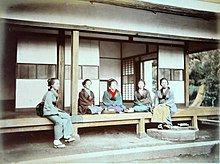

An engawa (縁側/掾側) or en (縁) is an edging strip of non-tatami-matted flooring in Japanese architecture, usually wood or bamboo. The en may run around the rooms, on the outside of the building, in which case they resemble a porch or sunroom.
Usually, the en is outside the translucent paper shōji, but inside the amado (雨戸) storm shutters (when they are not packed away).[1][2] However, some en run outside the amado. En that cannot be enclosed by amado, or sufficiently sheltered by eaves, must be finished to withstand the Japanese climate.[3] Modern architecture often encloses an en with sheet glass. An engawa allows the building to remain open in the rain or sun, without getting too wet or hot, and allows flexible ventilation and sightlines.[4]
The area under an engawa is sloped away from the building, and often paved, to carry water away. The area directly outside the paving is usually a collector drain that takes water still further away.[3] The engawa is thus a way to bridge the obstacles good drainage puts between the indoors and the outdoors.
- ^ 縁 [En]. The Daijisen. Shougakukan. 1995.
- ^ "Shoji Screens". www.rothteien.com.
- ^ a b A., Kester, Jeffery (18 March 2017). "The Kester House & Garden". kesterhouse.com.
{{cite web}}: CS1 maint: multiple names: authors list (link) - ^ Cite error: The named reference
oldphotoswas invoked but never defined (see the help page).